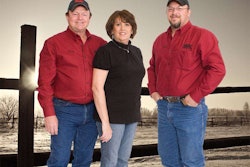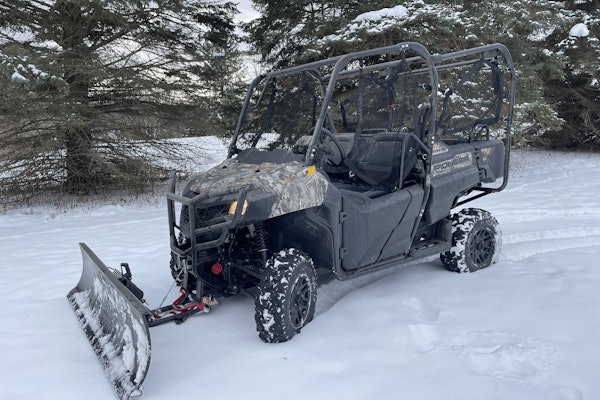Tom Brunton, Marysville, Tennessee and Venice, Florida
Professional image and execution, rigorous safety procedures plus an environmental emphasis bring growth and high dollar clients
For Tom Brunton, succeeding in construction is mostly a matter of mindset. “Don’t let anybody say you can’t do it and don’t listen to the naysayers. If you want it bad enough you can have it,” he says.
Growing up in Venice, Florida, Brunton figured out at age 14 that he wanted it, when a friend’s dad, Buddy Bryson of Bryson Masonry, offered him a job on weekends and summers. Brunton jumped at the chance and never looked back.
After finishing school Brunton continued to grow his skills full time working for two other masonry contractors. In 1992 at the age of 28, with not much more than a pickup and a wheelbarrow, he launched his own business as a sole proprietorship. Growth came gradually, but a willingness to travel helped propel the company to the next level. “The jobs that were available locally were smaller, so we said we’d gladly go someplace else and do the larger jobs, and that’s what catapulted us to the larger size.
One of his first big breaks was a two-and-a-half year job doing the block and brick work on Wal-Marts throughout Ohio. Brunton took a team of his best masons, many of them Hispanic, north for the duration. Working, eating and living with these crews, Tom developed another skill that would serve him well in the future – the ability to speak Spanish.
Divide and grow
A big job in Knoxville convinced Brunton that Eastern Tennessee might be more conducive to growth than the southern tip of Florida. In 1999 he split the company in two, taking about 40 volunteers to Marysville, Tennessee, on the outskirts of Knoxville, while still leaving a contingent behind in Florida. The move was well timed. East Tennessee was booming, and everybody wanted brick.
Since moving to the Knoxville area he’s done a lot of work for the University of Tennessee including a major masonry refacing project at the Vols’ Neyland Stadium, as well as a masonry job at the storied Bristol Motor Speedway. Business has been so good in Tennessee that he even recently opened up a third office in Johnson City, two hours to the north.
Safety pays
“We train everyone in all aspects of safety from the ground up,” Tom says. In addition to general safety training, the company also concentrates on the specific safety needs of masonry jobs: scaffolds, fall protection and forklift training. Brunton has at least two OSHA- certified-competent people in each of these disciplines and one OSHA- certified-to-train person in the company for in-house training. All his supervisors are CPR trained, and Brunton makes full use of factory and dealer training on scaffolding and equipment.
In addition to the training for company safety leaders, crews have monthly in house training at the office and weekly job-box/tailgate training sessions. A designated company safety person visits each site every week and photographs things that need correction. He has also started putting GPS on many of the company vehicles to monitor speed and safe driving, resulting in lower insurance costs.
The payoff for all this safety training is that the company hasn’t had a lost time accident in 10 years. And Brunton’s aggressive safety program has also benefited contractors who he works with.
“He’s really helped me advance my understanding of safety issues and preparation for OSHA inspections,” says Tom Wessell of Tom Wessel Construction, Sarasota, Florida “He opened our eyes to the right procedures.”
Managing the business
Safety is just one part of the professional image Brunton Masonry projects to the public. He maintains a nice-looking office and lobby for clients and does not shy away from the paperwork and business management. As much as he loves to sling a trowel like he did in the old days, he knows his days of working in the field and out of his house are gone.
“I used to wear all the hats. But it got to be too much so I hired a controller and an accountant and a secretary,” he says. He’s also added two estimators and has plans to train one more.
“Your typical mason is not the most sophisticated contractor, but Tom has a handle on everything. He knows how to run a job,” says Wessell. “He’s got a style we could all learn from.”
Green in word and deed
Another part of Brunton’s professional image, and one that’s important to hospitals, universities and other big clients, is the company’s emphasis on the environment. Brunton strives to use biodiesel whenever possible and the company recently purchased its first hybrid vehicle. Brunton has also invested considerable time and effort in getting his company certified in the Leadership in Energy and Environmental Design program.
The LEED program is a way of measuring the environmental efficiency and impact of buildings and construction processes and is run by the U.S. Green Building Council. And it’s not just window dressing. The accreditation process takes a lot of construction knowledge and months of study.
Brunton’s wife, Andrea, is the firm’s senior estimator and has recently become certified as the company’s first LEED Accredited Professional. And two additional employees are also studying to get their LEED AP certification.
“We’re doing a lot of work with Skansa USA,” Brunton says. “In a lot of their projects you are expected to be LEED certified.” Brunton estimates that 15 to 20 percent of the company’s jobs are requiring LEED certification, and that figure is growing. (For more information on LEED check out the website: www.usgbc.org.)
Promote from within
A company of this size with this many skilled tradespeople could not execute high caliber work without dedicated employees. And Brunton’s strategy for keeping employees is simple. “We try to promote from within as much as we can,” he says.
Before he started his own company Brunton said the only way he was able to advance in his career was to quit one company and go to work for another at a higher level, a situation he strives to avoid within his own employees. “We try to keep them in-house and let them know that there is a position above where they are at that they can move into if they’re willing to do the work that’s necessary,” he says.
Surviving the recession
Brunton is well aware that the current recession has been brutal for contractors. He knows several that have closed their doors, but his company still has a good bit of work, thanks in large part to a lifelong habit of paying attention to the numbers.
“It used to be if you had one bad job and two good jobs you’d make enough to cover all of them,” he says. “With the recession that doesn’t work. Every single job has to be profitable and you have to be paying attention because you won’t get a chance to recover.”
Brunton’s focus on the numbers didn’t start with the recession or after he got to a certain size. It’s been a life-long habit. He uses accounting and estimating software as well as customized spreadsheets he’s developed over the years. “We compare actuals to estimates and do extensive research into every job. I don’t think you can have enough control over making sure you know where the money’s going.”











